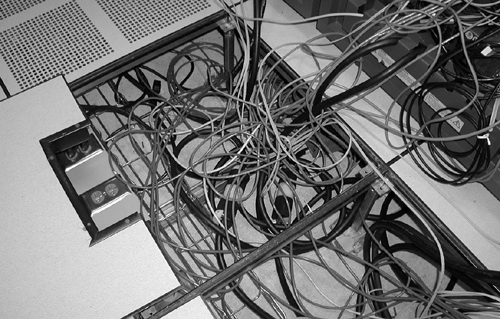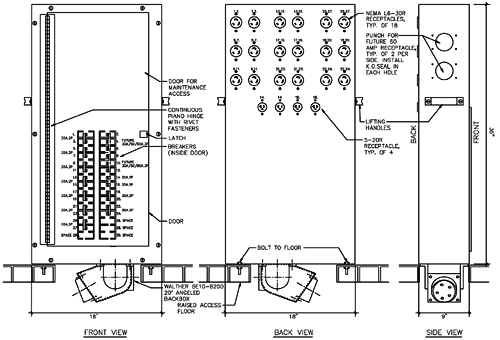Wiring and Cabling
| All wiring and cabling should be designed and installed in accordance with NFPA 70 of the National Electrical Code, or superseding national or local codes. All wiring and cabling should be run in an orderly and efficient manner, not like the "spaghetti" shown in the following figure. Figure 7-5. Disorganized Cabling Under Floor Tiles Data centers undergo frequent modifications, so any obsolete cabling should be removed to avoid air flow obstructions and minimize confusion and possible disconnection of the wrong cables during modification. Note Temporary extension cords should not be used in the subfloor void. If used above the raised floor, precautions should be taken to ensure that they don't pose a tripping hazard , and that they are not damaged. Higher Amps and Single-Phase or Three-PhaseThe main power feeds that enter a building are usually three-phase. Devices called transformers take the three phases of that power and convert them to three separate single phases. However, some computer equipment and support equipment runs on three-phase power only. Single-phase and three-phase power use different outlets, wiring, and circuit breakers. Use RLU definitions (see Chapter 4, "Determining Data Center Capacities") to determine how much single- and three-phase power you will need. However, flexibility is an important part of design methodology, and we know that technology changes. It is possible that computer and network equipment suppliers will need to move larger systems to the use of three-phase power or higher amperage. Some already offer three-phase power as an option. So how can you design flexibility into your power system? One way is to gauge up your wiring requirements (pardon the pun). Consider this scenario: Currently all of your RLU definitions use only single-phase power, L6-30R 30 Amp outlets. If you were to use the standard wire gauge for these outlets it will be fine. You can reuse this wire if you move to a three-phase outlet, provided that it still uses 30 Amps. However, if you were to use a standard wire gauge for 50 Amps, then this wire gauge would meet or exceed code requirements for the L6-30R 30 Amp outlets. Basically, you can use a larger gauge wire than is standard, but, not a smaller gauge wire. If you think you will need to change or upgrade power in the future, putting in the larger gauge wire for future use is a good idea. With this larger gauge wire in place, if you need to change some outlets to run at a higher amperage, you already have the wire ready and waiting under the floor. Redistributing outlets from single-phase to three-phase is simple if the three-phase outlets run at the same amperage as the single-phase outlets they replace. For example: If you had three L6-30R single phase outlets each on their own circuit breaker, you could move to three-phase outlets of the same voltage by replacing only the outlets and swapping three of these single-phase circuit breakers for two three-phase breakers. The following figure shows a section of electrical wireway for supporting the electrical requirements of two RLU Superset-A and one RLU-C. Figure 7-6. Blueprint Plan of a Standard Electrical Wireway and Outlets Under the Raised Floor The wire gauge in the wireway can also support three-phase power as well as the current single-phase L6-30R existing outlets, since they are both running at 30 Amps. You can see four cutouts on the left side. These are already in the wireway so that, should three-phase power be needed later, six of the L6-30R outlets can be removed and the wiring used for four three-phase outlets. You can also see the labels for each outlet's circuit breaker. Six of these breakers can be removed at the sub-panel and replaced by four three-phase breakers. There is another way to solve this problem: Power Distribution Units (PDUs). Power Distribution UnitsHistorically, there was one or more power feeds into the building, and these power feeds fed transformers that would send portions of this electricity to sub-panels. These sub-panels contained the circuit breakers for each outlet on the floor. Wire for each outlet ran from the breakers out to the floor and terminated in an outlet. This is still is a fine system. However, if you need to change the outlet on the floor, you must change the breaker, the wire from the breaker out to the floor, and the outlet itself. In an operational data center, this is a difficult and time-consuming process. To run new wire out to the location on the floor means removing tiles in the raised floor. This leads to decreased pressure that can affect the proper cooling of operational equipment. While you could have flexibility in this system, it comes at a large cost to the smooth running of a working data center. A Power Distribution Unit (PDU) is a way to integrate the circuit breakers, wire, and outlets in a central location on the floor that can service one or more RLUs. In this example, a PDU has an in-feed of 100A three-phase power by way of a Hubble connector. This Hubble connector plugs into the PDU. Inside the PDU is a smaller version of a sub-panel with circuit breakers for each outlet in the PDU. These circuit breakers have wires which connect to the individual outlets in the PDU. A PDU being fed by a 100Amp three-phase Hubble connector could supply eight 30Amp single-phase circuits. Another might supply ten 20Amp single-phase circuits, and another might supply four three-phase 30Amp outlets. This gives a lot of flexibility in your electrical system. However, there are a few downsides to this design. The first concern is that it might not meet code. In the U.S., for example, the NEC is interpreted by local building authorities and can be superseded by other local electrical code. There are data centers in San Diego, California and Austin, Texas where PDUs under raised floors are acceptable to the local electrical code requirements. However, in Hillsboro, Oregon and Menlo Park, California, the use of PDUs under the raised floor are not acceptable under the local electrical code. Different states and different counties might have different interpretations of electrical code requirements. The following figure shows an example of a PDU. Figure 7-7. Blueprint Plan of a Power Distribution Unit The other downside to the PDU design is availability. Currently, PDUs are custom-made devices and can be subject to lead times of weeks or months to manufacture. This is not a problem if you have a lot of lead time before you make changes to your electrical outlets. However, in the real world, this luxury isn't always available. With foresight, PDUs of whatever type you anticipate the need for can be pre-manufactured, but this involves additional cost for the materials (box, circuit breakers, wiring, and outlets) and labor to make, and the additional cost of storing them. PDUs can offer a great deal of flexibility to your electrical design. However, your first requirement will be to find out if they will be acceptable to your local code requirements. And even if they are, they might not be the most cost effective model for your data center. |
EAN: 2147483647
Pages: 142


